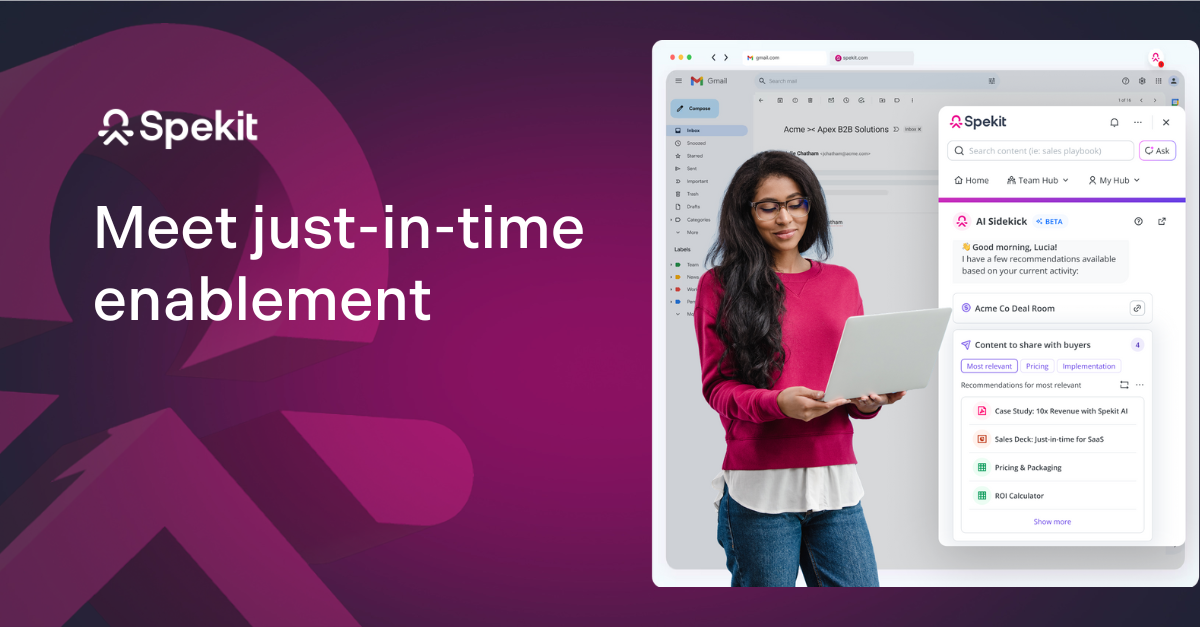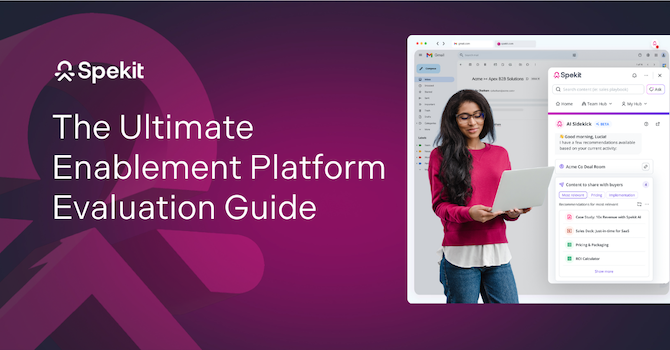Quick answer: what it is and why it matters
Just-in-time enablement delivers the exact coaching, content, and next best action to a seller in the tool and moment they are working. It unifies learning with execution so reps do not toggle tools or guess, they act. This approach counters the forgetting curve and boosts adoption because guidance arrives in context, not in a portal later.
Proof: Traditional platforms struggle with content decay and low rep use. 60.1% switch platforms due to difficult content management, while only 9.7% believe at least 60% of their content is used.
Definition: just-in-time enablement in plain terms
Just-in-time enablement is a modern enablement model that surfaces answers and coaching at the point of work, inside Salesforce, Gmail, Outlook, Gong, and Chrome. It blends micro-content, live context, and AI to eliminate search, reduce re-training, and accelerate execution.
This model exists to beat human memory limits. People forget most training within hours if it is not reinforced, which is why guidance in the moment matters.
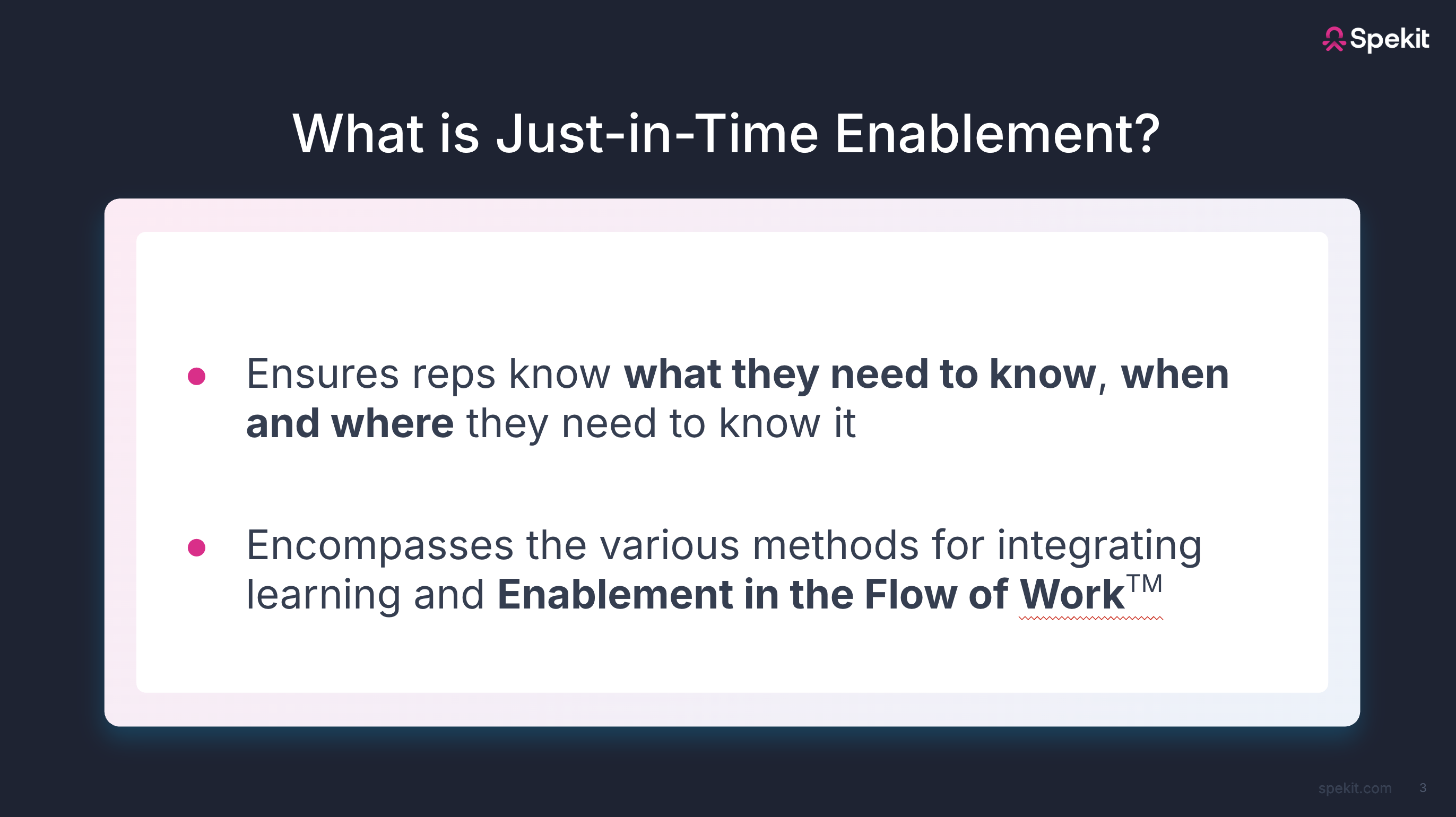
Why now: the cost of toggling and tool sprawl
Revenue teams toggle between apps about 1,200 times per day, losing nearly four hours each week to re-orientation. That's time not selling.
Sales leaders are responding by prioritizing better enablement and training to drive growth in 2025.
Spekit’s POV: unify content and learning in the flow of work
Spekit’s Just-in-Time Enablement approach delivers three things sellers actually use:
- AI Sidekick: a contextual assistant that reads the moment, then surfaces answers, playbook snippets, call coaching, and relevant assets without leaving the page. It works across Salesforce, Gmail, Outlook, Chrome, and Gong.
- Deal Rooms: lightweight spaces to share the right content with buyers and track engagement, aligned to the stage and stakeholders involved. The market is excited about digital sales rooms, yet adoption lags when execution is clunky. Spekit keeps it simple.
- Change alerts and governance: built-in change management, ownership, review cadences, and lifecycle rules that keep content current and reduce decay. Most teams struggle here, which drives costly platform switches.
The outcome is lower context switching, lower content decay, and higher adoption.
What sellers need, right now
Reps don't adopt portals or features disconnected from their flow of work. They adopt tools that give them the three to five things that directly impact deals.
The data confirms the misalignment. Enablers buy features reps do not use, and many features never get implemented at all. Keep it simple, deliver in-workflow, and measure usage.
Benefits: tangible wins with just-in-time enablement
1. Productivity gains that cut cost
Answers appear where the work happens, so reps spend less time searching and more time selling. HBR’s analysis on “toggle tax” quantifies the waste from app switching, which just-in-time models remove.
When leaders get the right insights, buy-in increases. The Salesforce State of Sales highlights improved enablement as a top growth tactic.
2. Less waste, more usage
Enablers report poor content adoption. For 24.2% of teams, over 80% of content is unused. A just-in-time model focuses creation on what gets used in the moment.
3. Faster reaction to market changes
Traditional training runs on a “push” model and loses to the forgetting curve. In-context reinforcement and small, searchable snippets win.
4. Better buyer experience
Digital sales rooms excite buyers and sellers in theory, but heavy features stall adoption. Lightweight Deal Rooms paired with AI Sidekick mean personalized follow-ups, relevant proof, and faster consensus.
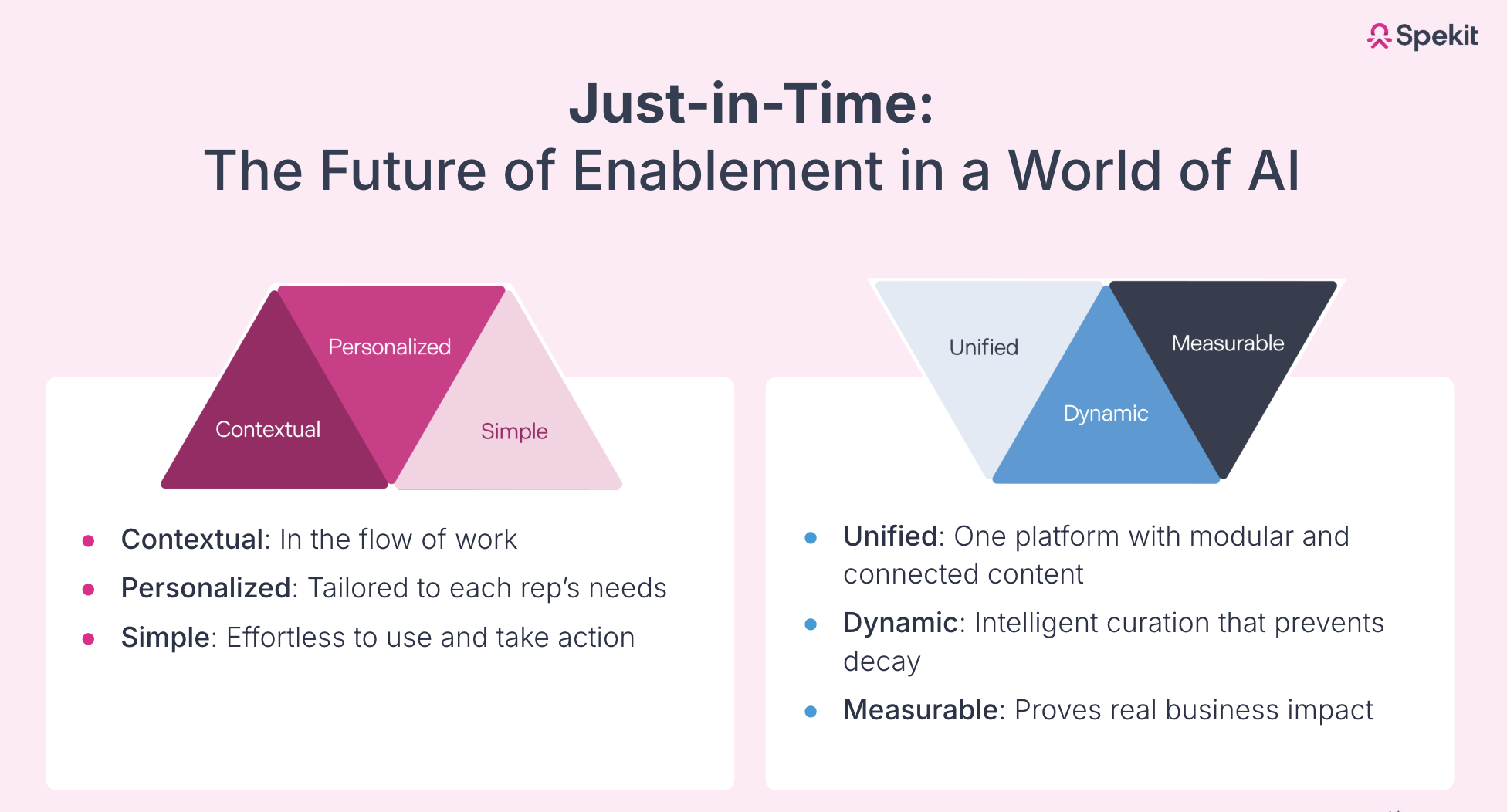
How Spekit delivers just-in-time enablement
AI Sidekick in your daily workflow
- Salesforce: stage-aware coaching, competitive call prep, pricing guidance, and policy answers at the field level.
- Gmail and Outlook: draft follow-ups with case studies and next steps based on call context.
- Gong and conversation intelligence: ingest snippets to suggest objection handling and surface content gaps to fix.
- Chrome everywhere: page-aware tips, flows, and micro-playbooks that show up on the right URL or field change.
Content that stays accurate
Governance and lifecycle rules prevent decay. Difficulty managing content is a top reason teams churn platforms, so Spekit makes creation, updating, and archiving simple.
Buyer collaboration that gets used
Deal Rooms align stakeholders and track engagement without a heavy lift. The market’s excitement for DSRs does not have to end in low usage if the workflow is simple.
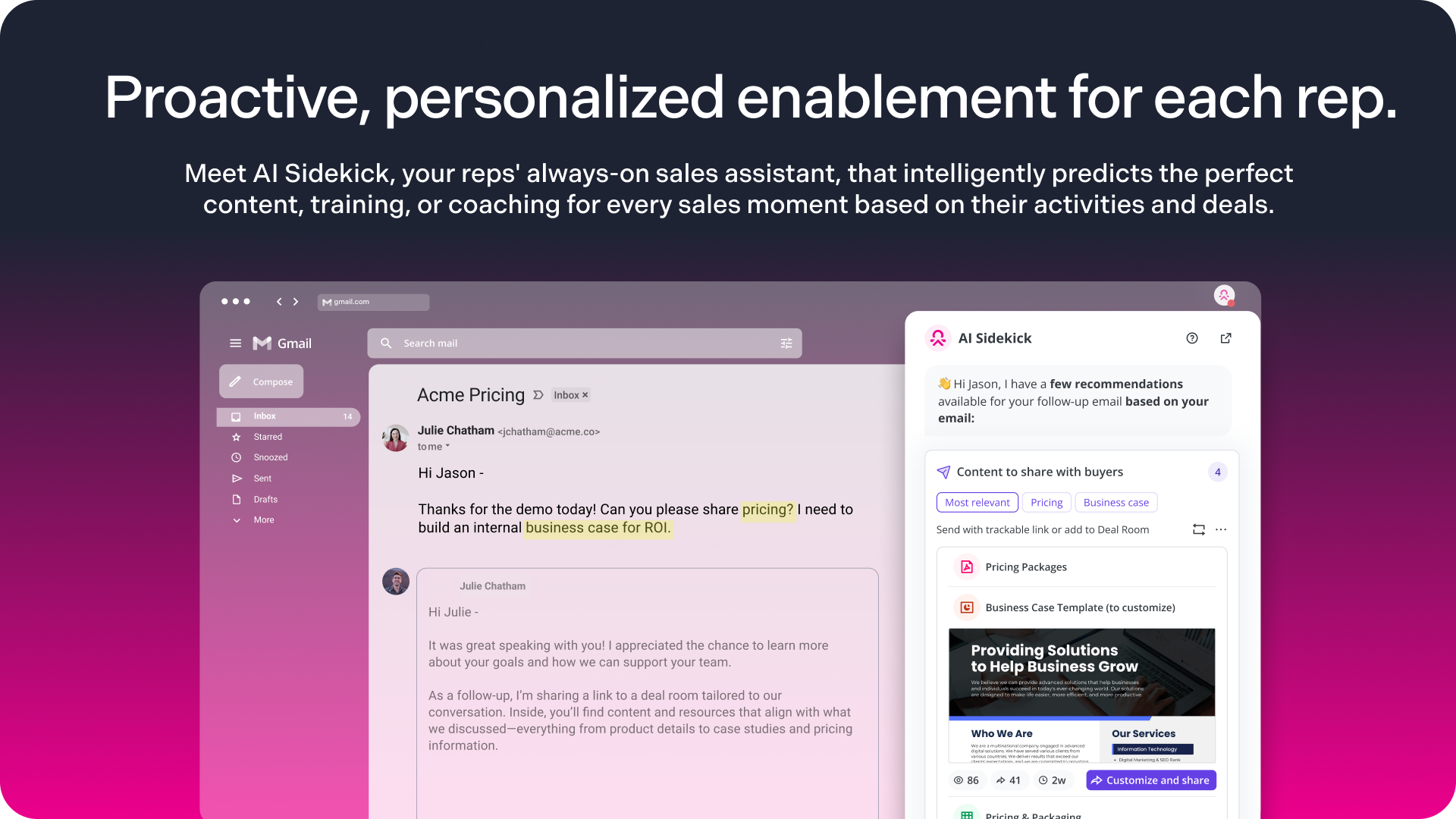
The importance of just-in-time enablement for the modern workforce
In our fast-paced, rapidly-evolving world, nobody has time to wade through a sea of irrelevant information. Enter, just-in-time enablement, designed for the modern workforce to:
- Increase efficiency and productivity by delivering crucial information contextually, when sales reps need it.
- With rapid technological changes, continuous learning is critical. Just-in-time enablement ensures that learning never stops (see our post on everboarding for more info).
- Support quick decision-making. Teams can respond to changes rapidly, keeping pace with the market demand.
Remember, change is the only constant in business. And just-in-time enablement is agile enough to adjust each time a curveball is thrown at us.
Objections and crisp responses
- “We already have an LMS.” LMS is great for baseline training. It is a push model that fights human memory. You still need in-workflow reinforcement.
- “We bought an all-in-one platform.” Feature bloat does not equal ROI. Many features go unused or are never implemented. Buy what reps use daily.
- “Our leaders are not logging in.” 75% of leaders log in fewer than five times per quarter. Deliver insights where they live, and prove value through usage and outcomes.
- “We can't keep content fresh.” Governance and review cadences stop decay. Difficulty managing content is the number one reason teams switch platforms.
How to measure success
Enablement leaders struggle to connect content to outcomes when everything sits in separate systems. The path forward is to measure actions taken in the workflow, not portal logins.
Track these five signals weekly:
- Findability: time to answer in Salesforce or email.
- Usage: Sidekick snippet opens and completions by stage.
- Coverage: content by question and stage against live pipeline.
- Conversion: stage-to-stage rates for opportunities that used Sidekick or a Deal Room.
- Quality: governance health, refresh rate, and owner SLA.
As insights build, you can see what top performers consume and reinforce the patterns for the rest of the team.
Comparison: old portal model vs just-in-time
Old model: pushes training and files into a portal. Content decays, features go unused, leaders lack visibility.
Just-in-time model: pulls the right micro-answer into the page where work happens, then measures actions and outcomes.
Practical setup examples
- AI Sidekick in Salesforce: When a rep updates stage to “Proposal,” Sidekick surfaces pricing guardrails, a relevant case study, and the follow-up email template.
- Gmail follow-up from Gong calls: Sidekick analyzes call topics and inserts a tailored summary with links to a Deal Room.
- Chrome on competitor pages: When a prospect mentions a competitor, Sidekick triggers the battlecard and talk track.

Measuring the ROI of just-in-time enablement
1) Cost reduction through boosted productivity
First and foremost, just-in-time enablement is your best buddy for shaving off those extra zeroes from your expenses. Why? Time is money.
Teams are using more applications to get their work done, complete processes, and access information than ever before. The result? Employees are forced to “toggle between different apps and websites 1,200 times each day,” according to a study by Soroco.
1) By reducing context-switching and automatically surfacing the answers or resources your reps need, you can save them up to two hours per day! That’s two more hours they can spend selling, prospecting, cold calling, personalizing, and building a big-fat pipeline.
PRO TIP: Calculate what context-switching is costing your organization with our calculator here!
2) It’s a superpower that lets your reps consume exactly what’s needed when needed. Take that, unnecessary digging, hunting, reading, and waiting 💪!
2) Elimination of waste and inefficiencies
Next! Up to 90% of marketing content goes unused. Can you even calculate the expense of this unused content? We’re talking months and months of time and energy invested into creating resources that sit around and collect dust.
Why? Because if something is inaccessible, hard to find, or inconvenient, guess what? Sales reps won’t use it.
Just-in-time enablement is like the ultimate “inefficiency exterminator!”
By adopting this approach, you’re systematically banishing waste from your content creation by:
- Placing your content at the fingertips of your sales reps to increase engagement
- Helping you identify and eliminate non-value-adding content by analyzing content usage metrics
What’s the cherry on top? You now bid a sweet farewell to the clutter and chaos that traditionally make up your content management system by regularly removing content that isn’t driving results.
3) Improved responsiveness to market demands
Now let’s talk about the big M – Market Demands. Keeping up with ever-changing market fluctuations can be as tricky as acrobats performing on a tightrope! But here’s the good news, just-in-time enablement is as agile, flexible, and adaptable as possible.
Traditional LMS courses and lengthy training documentation can take weeks or even months to produce. With just-in-time enablement, you’re focused on creating enablement content specifically for what a rep needs to know at that moment.
That means you’re embracing a strategy that favors bite-sized microlearning.
Easier to create, edit, and adjust as your needs and market demands fluctuate.
4) Streamline the buyer experience and increase satisfaction
And last but not least, let’s not forget the most important people – our wonderful customers! With just-in-time enablement, you aren’t just helping your prospects understand the value of your product faster – you’re winning their hearts with a streamlined and informative buying experience.
It’s simple – with an enablement approach that matches resources with sales rep and prospect/customer questions, you can respond to prospects faster with resources that are more personalized and helpful to their exact needs.
So, there you have it! The just-in-time enablement low-down. Now all we need is some action. Ready to move faster than ever before? Let’s bring on the just-in-time revolution.
Strategies for implementing Just-in-time Enablement
Hold on to your seats because it’s time to dish out some hard-hitting strategies for embracing just-in-time enablement in your organization.
Implementing Just-in-time Enablement Software – Spekit
Spekit is the modern AI-powered enablement platform that unifies content management, enablement, and personalized guidance to help revenue teams automate workflows and close deals quicker.
It combines an intelligent content management platform with AI Sidekick, the just-in-time sales assistant™ that leverages signals from CRM, call intelligence, and communication tools to deliver personalized guidance, sales playbooks, content, objection-handling guides, and recommendations directly to reps right within their flow of work.
Sidekick embeds contextual AI agents into a rep’s daily tasks to anticipate needs and automate workflows like curating and creating content, or building Deal Rooms.
By surfacing personalized guidance and resources directly in their flow of work, Sidekick enables reps to prepare for calls, follow up, and launch custom Deal Rooms in seconds.
Granular analytics on content consumption and buyer engagement show sales leaders which initiatives move deals forward, what content directly impacts pipeline, and where performance breaks down. By combining these insights with AI-driven guidance, Spekit strengthens change management to drive stronger adoption and accelerate execution at scale.
Role of just-in-time learning in Sales Enablement
Here’s the thing: the pace of change in the business environment is accelerating faster than a cheetah on a caffeine rush. Thanks to our buddy, technology. To keep up, sales teams need information – the right information – and they need it now! That’s where just-in-time learning comes in.
Just-in-time learning is training provided at the point of need, ensuring knowledge is fresh, relevant, and immediately applicable to your sales situation. It gears up your sales teams with the relevant information just when they need it, allowing them to pivot on the fly, outmaneuver competitors, and close deals right faster.
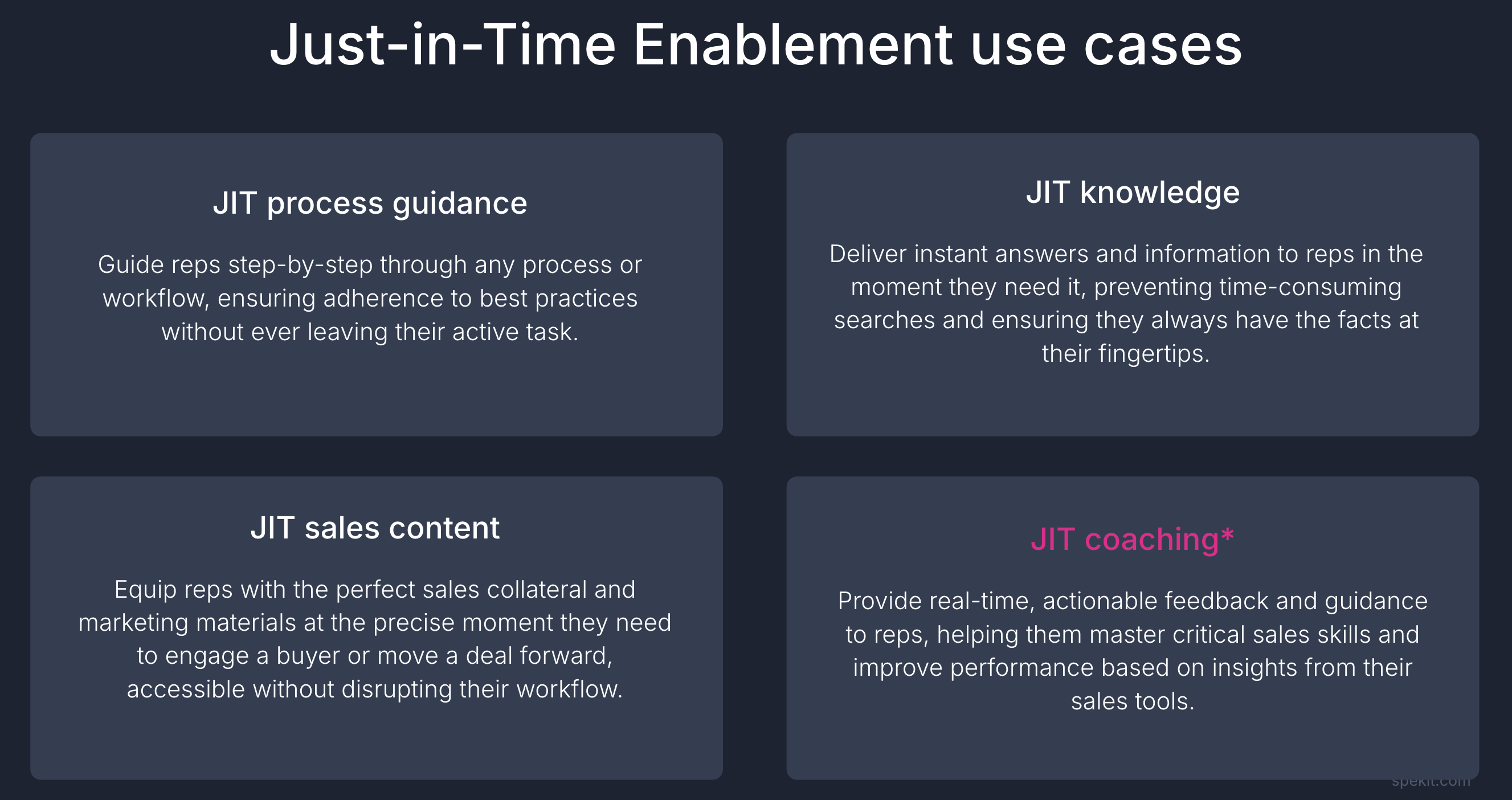
Creating dynamic and adaptable sales playbooks
Here’s where it gets juicy; The Sales Playbook. Imagine having a playbook that grows and evolves with your business – a flexible playbook that evolves with your sales process. Dynamism is the secret sauce to creating adaptable sales playbooks.
These playbooks aren’t your regular static strategy documents. They’re living, breathing, constantly adapting guides, taking cues from shifting customer needs, market conditions, and even feedback from sales reps. With the right sales playbook software, you can ensure your sales force never goes into the fight unarmored.
DOWNLOAD FREE Sales Playbook Templates ->
Leveraging just-in-time enablement for revenue growth
Now, let’s talk revenue. By now, you’re probably wondering, “How does all this translate into pipeline and revenue growth?” Well, I’m glad you asked!
Remember the context-switching productivity drain we talked about? Well, when your sales reps have access to the latest information, training, and strategies right when they need it, guess what happens? They improve their interactions with prospects, navigate conversations better, address concerns more effectively, and as a result, close deals more efficiently. The faster they close, the faster the cash flows in.
Case studies and success stories
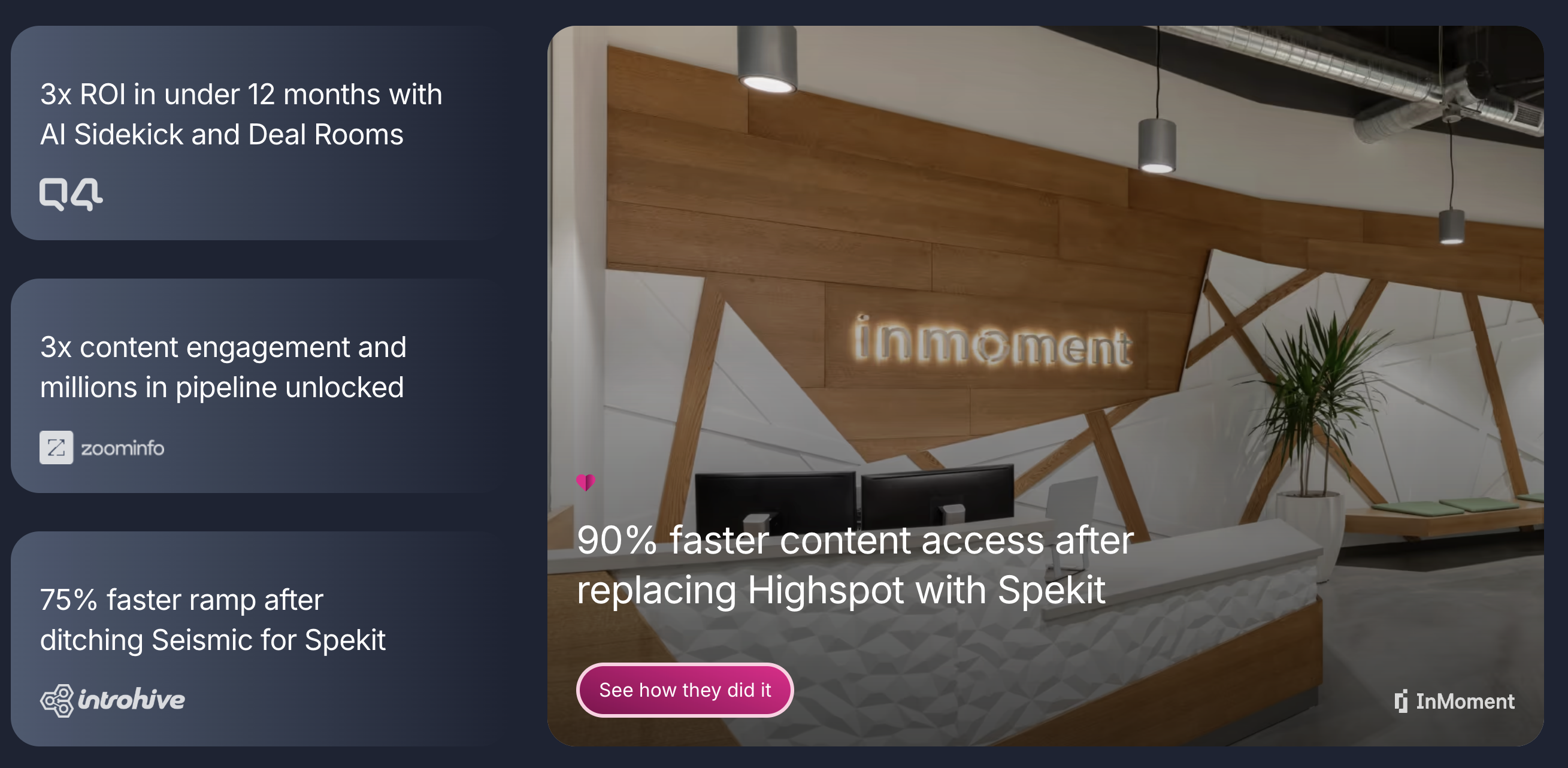
Now, let’s dive into some real-life examples to show the incredible potential of just-in-time enablement. It’s one thing to spin theories and expectations around something, but you can learn more from those who are actually implementing this strategy day in and day out.
Example 1: How InMoment cut search time 90% and shipped enablement in 39 days with Spekit
“In the first 30 days, we saw 92% license utilization, 84% extension usage, and 70% active usage.” — Jenna Siegel, Sr. Director of Revenue Enablement, InMoment
When an acquisition left InMoment with duplicate systems and a messy CMS, the team needed enablement in the flow of work, not another content graveyard. Spekit paired a lightweight CMS with just-in-time access so reps could get answers where they work.
What changed fast
- Live in record time. Seamless tech hookup in 24 hours and full rollout in 39 days.
- Daily adoption. 92% license utilization, 73% activation, 84% extension usage, 70% 30-day active usage.
- Less hunting, more selling. 90% less time searching for answers and content.
- Measurable impact. Real-time analytics replaced manual reporting that used to take three hours, with Salesforce tying content to pipeline and revenue.
Why it worked
- Contextual delivery. AI Sidekick surfaces the right answer at the right moment, inside the tools reps already use. (
- Unified and governed. A single source of truth replaces scattered docs and stale LMS links.
Read the full story → InMoment cuts search time by 90% switching from Highspot to Spekit.
Example 2: How Q4 reclaimed 4,000+ hours per quarter and drove 3× ROI with AI Sidekick and Deal Rooms
“Spekit hasn’t just changed how we work. It changed how we think about learning.” — Richard Thibault, Q4
Q4 started skeptical after clunky legacy tools. Once AI Sidekick and Deal Rooms landed, usage exploded and the business impact was clear.
What moved the needle
- 3× ROI driven by usage and productivity gains.
- 23× growth in engagement plus 30% fewer ad-hoc questions to managers.
- 71% lift in findability after AI Sidekick launched in Dec 2024: keyword searches up 32%, content views up 47%.
- Deal Rooms in under a minute. Hundreds created within weeks; one user spun up 37 in 30 minutes for a client initiative.
Why it worked
- Contextual and simple. Employees ask Sidekick and get immediate answers and content recommendations in Salesforce and email. Zero setup required. (Spekit)
- Unified and measurable. Spekit became the global knowledge hub, with Revenue Insights tying asset engagement to pipeline so marketing doubles down on what converts. (Spekit)
Read the full story → Q4 reclaims 4,000+ hours quarterly and 3× ROI with AI Sidekick and Deal Rooms.
Conclusion
Just-in-time enablement is not another tool to browse. It is a system that delivers knowledge and coaching at the exact moment of need. InMoment shows the speed and daily adoption that happens when content lives in the flow of work. Q4 shows the scale and ROI when AI Sidekick and Deal Rooms turn knowledge into action and tie it to revenue.
Next step
If you want the same outcomes, start where they did: unify content, enable Spekit AI Sidekick for contextual answers, and use Deal Rooms to educate buyers with one link. Then measure everything with Revenue Insights.

